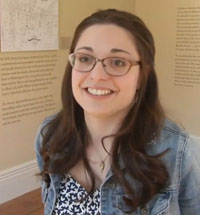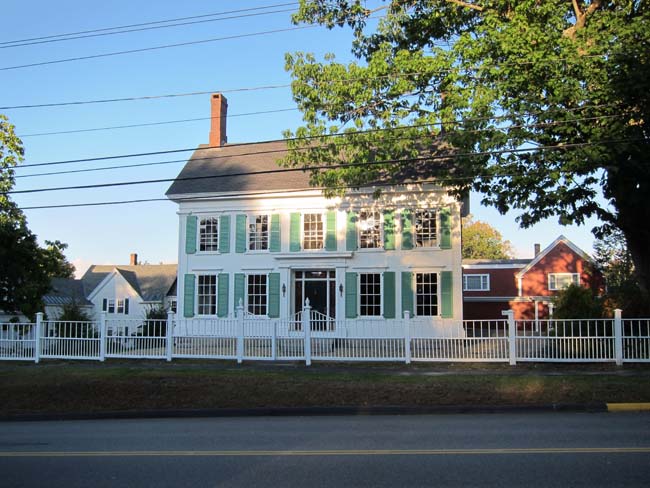Storied Stowe House: Katie Randall ’16 on Finding Passions at Bowdoin and in Its History

The College-owned Harriet Beecher Stowe House, a National Historic Landmark, added new chapters to its story this year with a significant national distinction and the opening of a public space, Harriet’s Writing Room. The house at 63 Federal Street where Stowe wrote Uncle Tom’s Cabin, the anti-slavery novel that some say helped spark the American Civil War, has been included in the National Underground Railroad Network to Freedom by the National Park Service.
Harriet’s Writing Room is open to the public Thursdays, Fridays and Saturdays, 12 p.m.–3 p.m. The Harriet Beecher Stowe House is at 63 Federal Street in Brunswick, Maine.
The designation recognizes significant contributions to the understanding of the Underground Railroad in American history and is a result of research by Katie Randall ’16, under the guidance of Associate Professor of Africana Studies and English Tess Chakkalakal. Randall writes of the findings—both historical and personal—she discovered along the way.
When I came to Bowdoin in 2012, I had a plan. I was going to major in art history and go on to be an architect. I loved art history from day one, but over my four years here, Bowdoin helped me discover historic preservation. I had the opportunity to research the Stowe House and participate in its rehabilitation, and working so closely with this amazing old building allowed me to explore and solidify a future in this niche field.
When I was a sophomore, I received an email from Associate Professor of Africana Studies and English Tess Chakkalakal. She was looking for a student to document the history of the Stowe House. At that time, the house had been unoccupied for more than a decade, and not many people knew about its connection with Harriet Beecher Stowe and Uncle Tom’s Cabin. There was even less consensus about the role the house should play in Brunswick and at Bowdoin, because the house had also been an inn and tourist attraction, roles that changed its appearance. In essence, it posed a complex historic preservation problem. John Cross, Bowdoin’s secretary of development and college relations, and its de facto historian, knew about my developing interest in this field, and recommended me to Professor Chakkalakal. And I, of course, jumped on board.

With funding from a Mellon Humanities Fellowship, I spent the summer of 2014 poring over structure reports, transcribing dozens of letters written by Harriet and her daughters from Brunswick, and gathering newspaper articles and brochures from the house’s time as an inn. I spoke to Susanna Ashton, an academic studying fugitive slave and author John Andrew Jackson’s connection with the house, and got my first tastes of archival research. Finally, I compiled a digital timeline that created a narrative of the house’s history and argued that its very historical complexity makes it an important landmark today.
All of the techniques I used to study and document the Stowe House are part of the practice of historic preservation. For me, working with the Stowe House was not only a way to learn local history, it was also a unique opportunity for me to get out of the classroom and run with a developing career path. When students have niche interests that are difficult to fully explore in coursework, fellowship opportunities like this are truly magical.
Ten months after the timeline went live on Bowdoin’s website, I was lucky enough to see the decaying house I had come to know so well rehabilitated as architectural firm Barbā + Wheelock and Bowdoin’s Stowe Committee together transformed the house into what it is today. The process was exciting in and of itself, but it also meant that I could continue working with the Stowe House and explore difficult questions of historic interpretation. What do this old building and its history mean now? What do we want people to learn from this building, and how do we make sure those messages come across?
There are so many interesting and exciting components of the Stowe House’s history that, for me, choosing one period and connecting it the present was the most difficult but exciting challenge. Eventually, Professor Chakkalakal, the Stowe Committee, and I started to formulate a connection between Harriet, John Andrew Jackson, and the present. They were two individuals who saw problems and chose to fight for change in the best way they knew: through the written word. Their legacy is still applicable today, and it became the focus of Harriet’s Writing Room and a way to connect the faculty offices currently in the building to the house’s story.
Working with the house for more than two years gave me the opportunity to see the power of historic preservation, to see a formerly defunct house begin to speak in the community again. The opportunities Bowdoin gave me would have been incredible enough had they only increased my passion for preservation, but they also allowed me to gain hands-on experience in the field, something to which few undergraduates have access. In large part as a result of working with the Stowe House, I am starting a dual master’s program at the University of Pennsylvania in historic preservation and city planning in the fall. As I spend the summer happily poring over course catalogues and books on preservation theory I have never been more grateful for the unique opportunity Bowdoin and its faculty gave me to revel in my interests and to have a hand in saving an incredibly important old house.